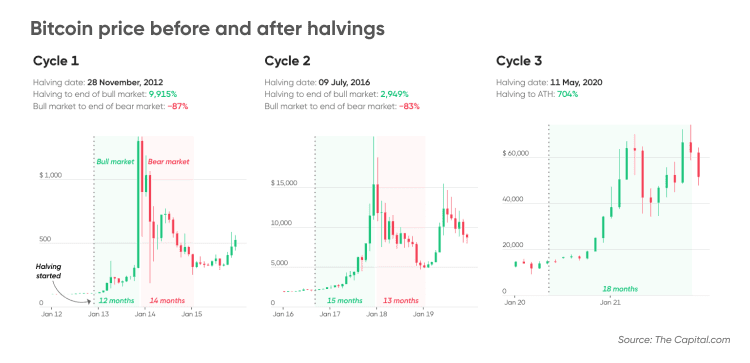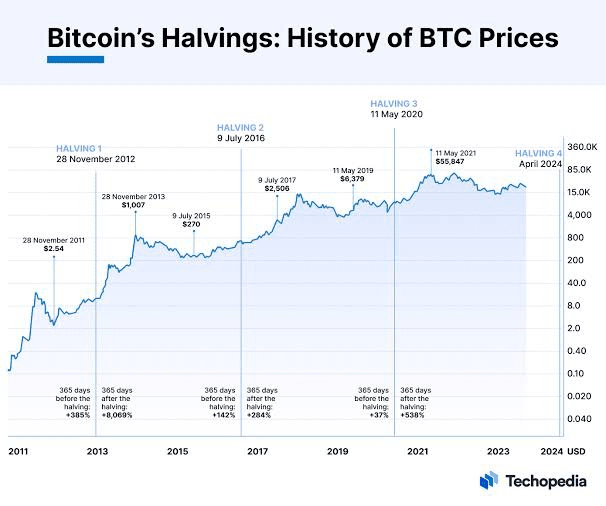Bitcoin halving, a programmed event occurring approximately every four years, has a profound impact on both the price and demand dynamics of BTC. The halving event reduces the rate at which new bitcoins are generated by half, making it a key element in Bitcoin's deflationary design.

Price Impact:
1. Supply and Demand Dynamics: Bitcoin halving directly influences its supply. With a reduced influx of new bitcoins, the available supply diminishes, assuming demand remains constant or increases. According to economic principles, a decrease in supply amid sustained or growing demand tends to drive up prices.
2. Historical Trends: Previous halving events have demonstrated a correlation between the reduction in supply and subsequent price surges. The halvings in 2012 and 2016 were followed by substantial bullish trends in BTC price. While historical performance is not indicative of future results, it provides insights into the potential impact.
3. Market Anticipation: Traders and investors often anticipate the halving event well in advance. This anticipation can lead to increased demand as participants seek to capitalize on potential price movements. The psychological aspect of scarcity contributes to a sense of urgency among market participants.
Demand Impact:
1. Scarcity Narrative: Bitcoin's fixed supply of 21 million coins contributes to its narrative as "digital gold." Halving accentuates this scarcity, aligning with narratives that position Bitcoin as a store of value akin to precious metals. This narrative can attract long-term investors seeking assets with limited supply.
2. Mining Economics: Bitcoin miners, responsible for validating transactions and adding new blocks to the blockchain, are directly affected by halving. The reduction in block rewards challenges the economic viability of mining operations. Some miners may exit the network, leading to a potential decline in sell pressure and an eventual supply-demand equilibrium.
3. Long-Term Investment: Halving reinforces the long-term investment thesis for Bitcoin. Investors looking beyond short-term fluctuations may view halving events as opportunities to accumulate an asset with a capped supply, especially if historical patterns repeat.
While Bitcoin halving introduces compelling dynamics, it's essential to acknowledge that various factors influence the cryptocurrency market. External events, regulatory developments, and macroeconomic conditions can intersect with halving's effects, shaping the overall trajectory of BTC price and demand. As always, thorough research and a comprehensive understanding of market dynamics are crucial for informed decision-making in the volatile crypto space.
How past halvings have impacted the Bitcoin price
There’s no reliable metric to measure the impact of the halving on prices. However, when looking at the past, a general trend does begin to emerge.
While it’s important to keep in mind that past performance doesn’t always indicate future results, the Bitcoin price tends to peak sometime around 18 months post-halving.
Here’s a brief rundown of how prices have performed after the previous three halving events.

2012 halving
On November 28, 2012, the first Bitcoin halving occurred, reducing the block reward to 25 from 50. For a while, the price didn’t move much. But one year later, Bitcoin reached a new record high at the time above $1,000.
2016 halving
The second halving event occurred on July 9, 2016, and prices quickly soared before correcting just as fast. In early 2017, Bitcoin began reaching new all-time highs over $1,000, and peaked near $19,000 by December of that year.
2020 halving
The third and most recent halving happened on May 11, 2020. This situation was unique as it coincided with a pandemic that impacted financial markets worldwide. Still, during the latter half of the year, a large rally began, culminating in record highs near $69,000 in late 2021.
As you can see, while there isn’t an exact pattern when it comes to Bitcoin prices post-halving, there does tend to be a strong correlation between halving events and prices.
This begs the question, “should I buy Bitcoin before the halving?”.
Price Prediction for BTC 2024
Minimum Price - $21,886.74
Maximum - $46,109.25
Average Price- $34,498.57
It can be difficult to say when the best time to buy Bitcoin might be. It depends on many factors, such as an investor’s risk tolerance, timeframe, and overall portfolio allocation.
That said, in the past there have been periods of accumulation leading up to the halving. During this time, prices tend to trade sideways or drift downwards. Some market observers have noted that the six months prior to the halving has historically been a good buying opportunity. Again, the past doesn’t always predict the future, but it does provide some insight into what could happen.
If this coming cycle were to resemble the previous ones, then market participants could expect a new all-time high for Bitcoin sometime around October of 2025 (18 months after the halving in April 2024).
In other words, anyone who plans on holding for at least 2 years might consider the current market environment to be an attractive buying opportunity.
Anyways everything in this article is my own opinion after doing some #DYOR🟢
Always follow your instincts and do your own research. God Bless #bitcoinhalving







